2.5 Configuring Preboot Services Defaults for ZENworks Imaging
You can configure Preboot Services default settings for a ZENworks Management Zone. These are settings that apply globally to all devices in the Management Zone.
Some of these settings enable you to automatically register devices with the ZENworks Server, and some can be overridden by configurations done for devices or folders containing devices. For more information, see Section 2.6, Overriding Preboot Services Defaults.
The following default settings can be configured in ZENworks Control Center:
2.5.1 Configuring Novell Preboot Services Menu Options
The Novell Preboot Services Menu provides options for how Preboot Services can be used on your devices. The following options are presented when the menu is displayed:
Table 2-6 Novell Preboot Services Menu Options
|
Menu Option |
Function |
|---|---|
|
|
Executes the assigned Preboot Services bundles. |
|
|
Displays the imaging maintenance mode prompt, where you can execute imaging commands. |
|
|
Prevents an existing ZENworks partition from being used when booting to execute the assigned Preboot bundles. |
|
|
Allows an existing ZENworks partition to be used when booting to execute the assigned Preboot bundles. |
|
|
Resumes booting of the device without doing any Preboot bundle work. |
Generally, if your Preboot Services work is completely automated, you should select to never display the Novell Preboot Services Menu on the device when it boots. Conversely, if you need to do manual Preboot Services functions for some or all devices, then select to always display the menu. A compromise is where you select to display the menu if Ctrl+Alt is pressed, allowing unattended Preboot Services work while allowing you the opportunity to display the menu when needed.
IMPORTANT:PXE must be enabled on the device for the menu to be displayed.
To determine whether the Novell Preboot Services Menu is displayed on your devices when they boot:
-
In ZENworks Control Center, click in the left pane to display the tab, then if it’s not expanded, click .
-
Click to expand its listing, then select to display the configuration sections.
-
Locate and expand the Preboot Menu Options section:
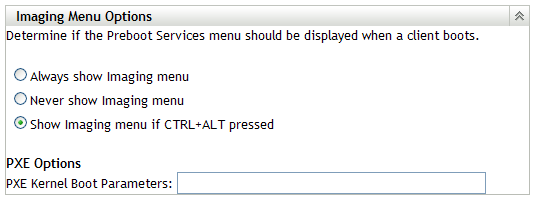
-
Select one of the following:
-
-
To provide PXE boot options, specify them in the field.
Each parameter should be separated by a space.
-
Click either or to save the change.
This sets the default menu display mode for the Management Zone. This can be overridden at the folder or device level. For more information, see Section 2.6, Overriding Preboot Services Defaults.
2.5.2 Configuring Non-Registered Device Settings
The following configurations can be set after a device is imaged. The settings are applied to devices that are not registered in the Management Zone and are placed in the devices’ image-safe data.
For more information, see Section 1.4.3, Non-Registered Device Settings.
To configure default ID settings for non-registered devices:
-
In ZENworks Control Center, click in the left pane to display the tab, then if it’s not expanded, click .
-
Click to expand its listing, then select to display the configuration sections.
-
Locate and expand the Non-Registered Device Settings section:
-
Fill in the fields:
DNS Suffix: Provides a suffix for all of your device’s names.
For example, if you enter “provo.novell.com” and a device’s name is “device1,” that device’s full name becomes “device1.provo.novell.com.”
Workgroup: Specify the Windows workgroup that you want the device to be a member of.
The workgroup is made part of the image for the device.
Name Servers: To control what DNS servers the device uses, specify a DNS name server, then click to place it into the listing.
So that a booting device can find a name server efficiently, specify multiple DNS name servers.
For optimal availability of a DNS server for a device, you can rearrange the order using and , one name server entry at a time.
You can delete multiple name servers by selecting them and clicking .
Device Name: You can specify the default device names for non-registered devices. The name is applied after the device is imaged.
This can be useful for when you have multiple devices to be imaged. You can automatically provide unique names for each device (from its BIOS asset tag or its BIOS serial number), as well as group devices by providing the same prefix for their names.
-
Use Prefix: ____: This provides a common prefix to the device names, such as Lab1, to distinguish them from the devices in Lab2. This can be useful when doing bulk imaging of certain groups of devices. It is limited to 8 characters.
If this option is used, the prefix you enter here is appended with a random string of letters and numbers to make the device name 15 characters long. Underscores and hyphens are valid in your prefix. The remaining random string uniquely names the device.
For example, if you enter Lab1_, then ten other characters are randomly generated to complete the name with Lab1 separated from the random characters by the underscore for readability.
-
Use BIOS Asset Tag: This is the asset tag stored in the device’s BIOS, which is unique for every device. This can be useful for tracking a device based on its asset tag.
-
Use BIOS Serial Number: This is the serial number stored in the device’s BIOS, which is unique for every device. This can be useful for tracking a device based on its serial number.
NOTE:To know the correct hardware or the BIOS information that the Imaging Engine will use, run the img -info command in the Maintenance mode.
-
Do Not Automatically Assign a Name: Select this option if you do not want to use any of the above options. This is the default option.
IP configuration: You can select either or to identify devices for Preboot Services work.
These are the settings that the device is told to use after it is imaged. It uses them for Preboot Services work any time it reboots.
For IP configuration, select one of the following options:
-
Use DHCP: Allows the devices to be dynamically assigned with IP addresses.
-
Specify Address List: Uses IP addresses to identify your devices. The addresses you add to the list are available to be used by your devices. This way, you can specify a range of IP addresses or individual IP addresses that you want your devices to use. For example, you can ensure that all of your lab devices use addresses between 10.0.0.5 and 10.0.0.25.
If you select , perform the tasks contained in the following table:
Task
Steps
Additional Details
Add an IP address range
-
In the panel, click to open the Range Information dialog box.
-
Specify a subnet mask in the field.
Device IP address ranges are provided by subnet masks.
-
Specify the subnet’s gateway in the field.
This assigns devices to the gateway for access to the Internet or network after the device has been imaged and rebooted.
-
To place IP addresses in the field, specify an address range using CIDR notation in the field, then click .
-
To remove an IP address range from the list, select the entry then click .
You can only remove address ranges, not specific IP addresses within a range.
-
Click to place the address ranges into the listing in the section.
After a device is imaged, IP settings are applied to the device. The IP address that gets assigned to the imaged device is no longer displayed in the available list, but is instead listed in the list.
The list in the Range Information dialog box indicates those that are currently being used by devices in the zone.
With CIDR (Classless Inter-Domain Routing) notation, the dotted decimal portion of the IP address is interpreted as a 32-bit binary number that has been broken into four 8-bit bytes. The number following the slash (/n) is the prefix length, which is the number of shared initial bits, counting from the left side of the address. The /n number can range from 0 to 32, with 8, 16, 24, and 32 being commonly used numbers. For example:
-
123.45.678.12/16 matches all IP addresses that start with 123.45
-
123.45.678.12/24 matches all IP addresses that start with 123.45.678
Remove IP addresses from the listing
-
Select the check boxes for one or more IP address entries in the list, then click .
Remove displayed IP address ranges from the Range Information dialog box
-
In the panel, click to open the Range Information dialog box.
-
In the Used Address Ranges section, select an IP address range in the listing, then click .
Remove specific IP addresses from the Range Information dialog box
-
In the panel, click to open the Range Information dialog box.
-
In the Used Address Ranges section, enter a specific IP address or a range of addresses in the field, then click .
Edit an IP address entry
-
Select the check boxes for an IP address entry in the list, then click to open the Range Information dialog box.
-
Modify the information as necessary.
-
Click OK to save the changes.
-
-
-
Click either or to save the changes.
This sets the default device ID method for the Management Zone.
2.5.3 Configuring Device Imaging Work Assignments
You can determine what imaging work is to be performed on a device when it boots, based on a set of hardware rules. This configuration section lets you specify a particular bundle for each set of hardware rules. The Custom Hardware Types section allows you to provide specific data for a hardware rule option.
All rules and custom types configured here are applied globally to all managed devices in the Management Zone. However, only those devices that exactly match the rule and its custom types have the assigned bundle applied to them when they boot.
For more information, see Section 1.4.4, Device Imaging Work Assignment.
To configure default imaging work assignments for non-registered devices:
-
In ZENworks Control Center, click in the left pane to display the tab, then if it’s not expanded, click .
-
Click to expand its listing, then select to display the configuration sections.
-
Locate and expand the Device Imaging Work Assignment section:
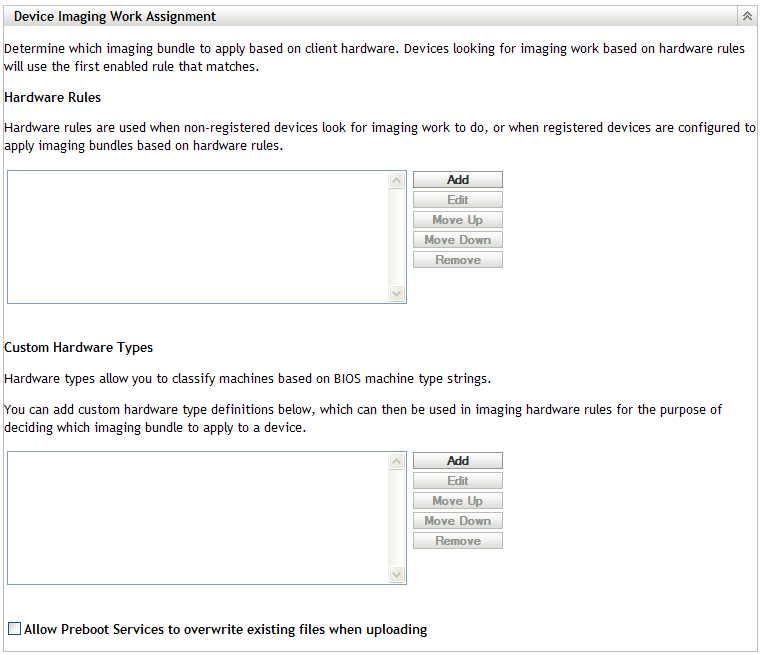
-
Configure the following:
-
Click either or to save the changes.
This sets the default imaging work assignments for devices registered in the Management Zone.
Hardware Rules
You can specify hardware-based rules for a Preboot bundle. This enables any device matching those rules to have the specified bundle applied to it when it boots.
For example, you can create a rule that applies a bundle to any device with at least 512 MB of RAM and 150 GB of hard drive space.
A work rule is made up of filters that are used to determine whether a device complies with the rule. The rules use logic to determine whether a device meets the requirements for applying the Preboot bundle. The AND, OR, and NOT logical operators are used for creating filtering for the rule.
When a device is seeking work to be done, it scans the rules until it finds a rule where all of the rule’s filters match the device, then executes the bundle assigned to the rule.
The following table lists the tasks you can perform to configure hardware rules:
Table 2-7 Hardware Rules Tasks
|
Task |
Steps |
Additional Details |
|---|---|---|
|
Add a hardware rule |
|
The information that you configure in the Rule Construction dialog box comprises one rule. You can add multiple rules. Each time you click to use the Rule Construction dialog box, you can select the same bundle as the previous time that you used the dialog box, or you can select a different bundle for the rule. Only the first hardware rule that is matched is used when a device boots to apply the assigned bundle. |
|
Edit a hardware rule |
|
|
|
Disable or enable a hardware rule |
|
This is the only way to change the status of a hardware rule. Whether a hardware rule is enabled or disabled is indicated in the list box. For example, Enabled - Asset Tag Rule. |
|
Rearrange the order of the hardware rules |
|
The hardware rule order is important because when the device boots, the first rule that is found to match the device is used to apply the bundle. The other rules are ignored. This means that only one bundle can be applied to a booting device by virtue of a hardware rule match. |
|
Remove hardware rules |
|
You can use the Ctrl or Shift keys to select multiple hardware rules to remove them from the list. If you remove a hardware rule, any work you did to create it is lost. Removed rules do not have any of their information saved anywhere. Therefore, if you only want to remove the rule temporarily, take note of the rule’s content before deleting it so that you can more easily re-create it. For example, either select it and click and note the data, or take a screen shot of the dialog box. |
Rule Construction Dialog Box
Understanding rule logic is important in using this dialog box. For more information, see Rule Logic.
To configure a hardware rule:
-
If you plan to select when constructing a rule, you must first configure the hardware type.
For instructions, see Custom Hardware Types.
-
Click in the Hardware Rules section to display the Rule Construction Dialog box:
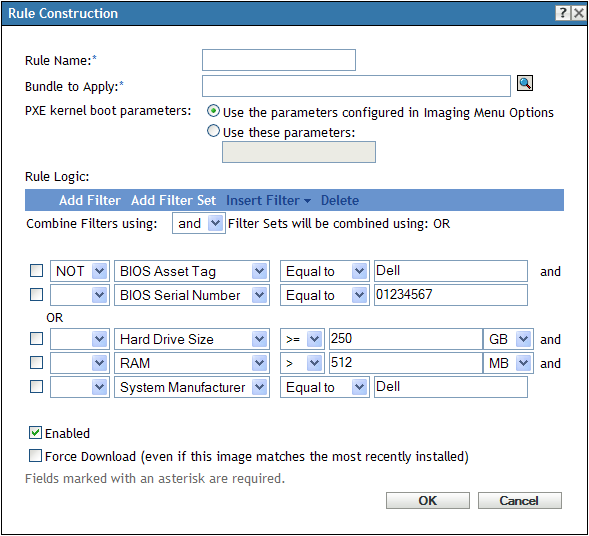
NOTE:To know the correct hardware or the BIOS information that the Imaging Engine will use, run the img -info command in the Maintenance mode.
-
In the Rules Construction dialog box, fill in the following fields and select or deselect the options:
Rule Name: This name is displayed in the rules listing on the page in the section. Make it descriptive enough that you can later remember its purpose.
Bundle to Apply: When a device is seeking work to be done, it scans the rules until it finds a rule where all of the rule’s filters match the device, then executes the bundle assigned to the rule. Each rule can be applied to only one bundle.
Because the rules, not the bundles, are listed in the section, you can apply multiple rules to a given bundle. This means that a bundle has multiple chances to be selected for device imaging work.
When multiple rules are listed, the first rule with criteria to match a device causes that rule’s assigned bundle to be applied to the device.
If no rules match a device, then none of the applicable bundles are applied to the device.
PXE Kernel Boot Parameters: Select one of these two options:
-
Use the Parameters Configured in Imaging Menu Options: This causes the rule to use the default boot parameters for the Management Zone.
-
Use These Parameters: Only the boot parameters that you specify here are used for this rule.
Each parameter should be separated by a space.
Enabled: This is the only way that you can temporarily disable a hardware rule. It is enabled by default.
The rule’s status is shown by the first word in the work rules listing on the page. For example, Enabled - Asset Tag Rule.
Force Download: Forces the download of the assigned bundle, even if it matches the most recently installed bundle. By default, downloading the hardware rule is not forced.
By default, ZENworks imaging does not reimage a machine containing the same image. This option allows you to force the image to be reapplied to the device. For example, you might want to refresh all of your lab machines for the next use of the lab.
IMPORTANT:Use this option cautiously. It can create an endless loop, because the option remains selected after an image has been applied. If you image a device that remains non-registered after it is imaged, it is reimaged with the same image over and over each time it boots. To prevent this, edit this hardware rule and deselect this option after you have imaged the applicable devices.
-
-
Using the fields and options, create the hardware rule expression using the following options:
-
Add Filter: Adds the new filter at the end of the list of filters.
Because the filter is added to the end of the last filter set, you cannot use this option to select which filter set to add it to. Use the option to add a filter into an earlier filter set.
-
Add Filter Set: Adds a new set of filters, beginning with one filter in the set. The filter set order cannot be rearranged.
-
Insert Filter: Allows you to insert a new filter either above or below the selected filter. This also enables to you specify which filter set to add a filter to.
-
Delete: Removes the selected filters from the rule.
-
Combine Filters Using: The default is to have filters ANDed and filter sets ORed. You can use this field to reverse these Boolean functions for the filters and sets.
Using OR for filter sets means that all filters in a set must be matched to apply the rule, but any of the sets can be matched to apply the rule.
Using AND for the filter sets means the reverse. At least one filter in each set must be matched for the rule to be applied.
An expression consists of a criteria option, operator, and value, and in some cases, a qualifier. For example:
RAM (in MB) =< 512 MB
RAM (in MB) is the criteria option, =< is the operator, 512 is the value, and MB is the qualifier.
If necessary, you can use NOT (in the first blank field with a down-arrow) to perform a logical negation of the expression. For example:
NOT RAM (in MB) =< 512 MB
In the above example, the rule is applied only to devices with less than 512 MB of RAM.
You can use more than one expression for the rule. For example:
RAM (in MB) =< 512 MB or
Hard Drive Size (in MB) < 20 GB
displays in the criteria options list only if you have previously configured a custom hardware type and saved it by clicking at the bottom of the configuration page.
IMPORTANT:Be aware of the possibility of creating conflicting filters or rules. For example, if you specify a RAM condition in multiple filters, make sure the effective logical operators where each is configured make sense for the megabyte values that you enter. In other words, if two filters are both required (ANDed), you would not want one filter to require exactly 512 MB of RAM and the other to specify at least 512 MB of RAM.
-
-
Click to exit the dialog box and place the new hardware rule into the list box on the configuration page.
Rule Logic
A rule is made up of one or more filters that are used to determine whether a device complies with the rule. The Rule Construction dialog box begins with one empty filter. A device must match the entire filter list of a rule (as determined by the logical OR nd AND operators that are explained below) for the rule to apply to the device.
A filter is a row of fields providing a condition that must be met by a device in order for the bundle to be applied. For example, you can add a filter to specify that the device must have exactly 512 MB of RAM in order to be accepted by the rule, and you can add another filter to specify that the hard drive be at least 20 GB in size. There is no technical limit to the number of filters that you can add in the rule, but there are practical limits, such as:
-
Designing a rule that is easy to understand
-
Devising the rule so that you do not accidentally create conflicting filters
-
Being able to view the dialog box as it grows in size because of the filters and filter sets that you add
Filters can be added individually or in sets. Each set contains logical operators within the set and logical operators determine the association between the sets.
By default, the logical operator AND is displayed for the filters within a set in the field (which you can change), and OR is displayed in the field (display-only). If you change the field to OR, the field then displays AND.
You can think of filters and filter sets as using algebraic notation parentheticals, where filters are contained within parentheses, and sets are separated into a series of parenthetical groups. Logical operators (AND and OR) separate the filters within the parentheses, and the operators are used to separate the parentheticals.
For example, “(u AND v AND w) OR (x AND y AND z)” means “match either uvw or xyz.” In the Rule Construction dialog box, it looks like this:
u AND
v AND
w
OR
x AND
y AND
z
Filter sets cannot be nested. You can only enter them in series, and the first filter set to match the device (the default of OR) is used to validate the rule so that the bundle can be applied to do imaging work on the device.
The order in which filters and filter sets are listed does not matter. For the OR operator, the first to be met satisfies the rule. For the AND operator, all items must be met to satisfy the rule.
HINT:You can easily run a test to see how these logical operators work. Access the Rule Construction dialog box, click both the and options a few times each to create a few filter sets, then switch between AND and OR in the field and observe how the operators change. Then, either select the filters that you added and click , or click to exit the Rule Construction dialog box.
You can set up the conditions for a rule by adding all of the filters and filter sets that you need to identify the type of device you want to match. You typically do not need to set up complex rules. However, because you can apply multiple rules to a bundle, you can further complicate the use of logical operators, because each rule is considered to be an OR condition for the bundle, causing the bundle to be applied if any one of the rules matches the device.
For example, you could create several rules for the bundle with each rule being a long listing of AND conditions to be met. This means that each rule becomes a specific set of criteria for a device to meet, causing the bundle to be applied if one is met. Conversely, if you add that same amount of information into one rule (using filter sets for the AND and OR conditions), it might make the dialog box so long that it becomes unmanageable.
To determine what you need, consider the following possibilities:
-
One filter set with multiple filters
-
Multiple filter sets with only one or a few filters per set
-
Multiple filter sets each with multiple filters
-
Multiple rules per bundle
Remember that the logical operators for filters within a set are the opposite of the operators between the sets, and all rules for a bundle use the OR condition. For example, suppose you are selecting the operator in the field:
Table 2-8 OR and AND Operator Explanations
|
Operator |
Within Filter Sets |
Between Filter Sets |
Multiple Rules Per Bundle |
|---|---|---|---|
|
OR |
Only one filter in the set needs to apply to the device (OR condition). The first filter that applies is used. |
Each filter set must have one filter in it that applies to the device (AND condition). |
The first rule that applies is used (OR condition). |
|
AND |
All filters within the set must apply to the device (AND condition). |
Only one filter in the set must apply to the device (OR condition). The first filter that applies is used. |
The first rule that applies is used (OR condition). |
Obviously, adding filter sets complicates the use of logical operators, and adding multiple rules to the bundle further complicates it. Therefore, carefully plan how to configure your information before using the Rules Configuration dialog box.
Custom Hardware Types
Custom hardware types enable you to include any devices matching your custom type to have the bundle assigned to the hardware rule applied to them when the devices boot. For example, you can create a rule that applies the bundle to any device that is a laptop by entering the applicable string as a custom hardware type, selecting in the Rule Construction dialog box, then selecting your custom type.
The option does not display in the Rule Construction dialog box until at least one custom type has been configured.
The following table lists the tasks you can perform to configure custom hardware types:
Table 2-9 Custom Hardware Type Tasks
|
Task |
Steps |
Additional Details |
|---|---|---|
|
Add a custom hardware type |
|
In the Custom Hardware Type dialog box you can add multiple strings, which identify specific hardware type information in the device’s BIOS. The set of strings that you add in the dialog box is considered one custom hardware type that is identified by the name you also provide in the dialog box. The custom type won’t display in the drop-down list of hardware items on the Rule Construction dialog box until you click or to save the configuration. |
|
Edit a custom hardware type |
|
|
|
Rearrange the order of the custom hardware types |
|
The custom hardware type order is important because when the device boots, the first type that is found to match the device is used to apply the assigned bundle. The other types are ignored. |
|
Remove custom hardware types |
|
You can use the Ctrl or Shift keys to select multiple custom hardware types to remove them from the list. By removing a custom hardware type, any work you did to create it is lost. Removed types do not have any of their information saved anywhere. Therefore, if you only want to remove the rule temporarily, take note of the type’s content before deleting it so that you can more easily re-create it. For example, either select it and click and note the data, or take a screen shot of the dialog box. |
Custom Hardware Type Dialog Box
Custom hardware types enable you to include any devices matching your custom type and to have the bundle assigned to the hardware rule applied to them when the devices boot. For example, you can create a rule that applies the bundle to any device that is a laptop by entering the applicable string as a custom hardware type, then select in the Rule Construction dialog box and select your custom type.
The option does not display in the Rule Construction dialog box until at least one custom type has been configured.
Your custom hardware type definitions are applicable only to rules; they do not otherwise apply to the Management Zone.
Following is the Custom Hardware Type dialog box:
Figure 2-4 Custom Hardware Type dialog box
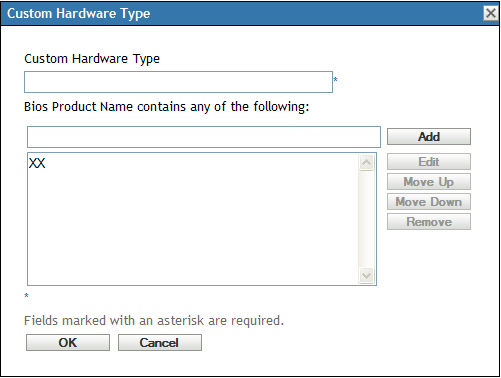
To configure custom hardware types, perform the tasks in the following table:
Table 2-10 Custom Hardware Type Tasks
|
Task |
Steps |
Additional Details |
|---|---|---|
|
Configure a custom hardware type |
|
The new custom type does not display in the Rule Construction dialog box until you have clicked to save it. The strings you can enter are anything that you want to match in the device’s BIOS. To determine the BIOS product names of your servers or laptops, use the img ‑i command at the imaging maintenance mode prompt, which displays various BIOS information. The BIOS information that you need is listed in the field. For servers and laptops, you can enter partial strings to select all BIOS product names containing that string. |
|
Edit a custom hardware type |
|
|
|
Rearrange the order of the strings in the list |
|
You cannot move multiple strings at a time. |
|
Remove strings from the list |
|
You can use the Ctrl or Shift keys to select multiple strings to remove them from the list. |
Allow Overwrites
Select the check box if you want existing .zmg files to be overwritten by a newer version when the image is taken.
2.5.4 Configuring the Server Referral List
Referral lists are used to make sure managed devices belonging to other Management Zones can access their home zone. For more information, see Section 1.4.5, Server Referral List.
-
In ZENworks Control Center, click in the left pane to display the tab, then if it’s not expanded, click .
-
Click to expand its listing, then select to display the configuration sections.
-
Locate and expand the Server Referral List section:
Figure 2-5 Server Referral List panel
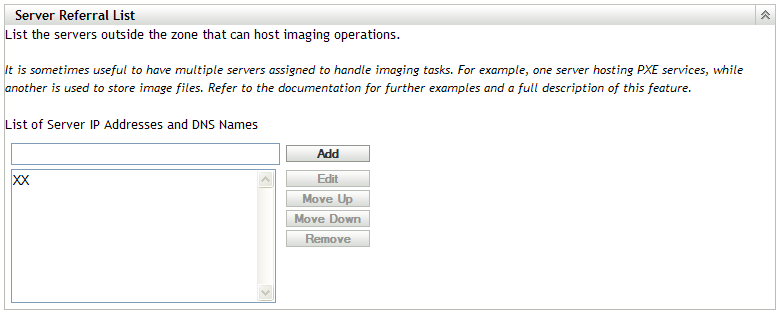
-
To configure a server referral list, complete the tasks in the following sections, as applicable:
Configuring Imaging Servers in the Server Referral List
To configure the list box, perform the tasks in the following table:
Table 2-11 Server Referral List Configuration Tasks
|
Task |
Steps |
Additional Details |
|---|---|---|
|
Add a server to the server referral list |
|
You can add a range of IP addresses by typing the beginning IP address, type a space, a dash, another space, then type the ending IP address of the range. However, these are displayed as you typed them when you click ; the addresses within the range do not separate into individual IP addresses in the list. |
|
Edit a listed server |
|
|
|
Rearrange the order of the servers in the server referral list |
|
You cannot move multiple servers at one time. |
|
Remove servers from the server referral list |
|
You can use the Ctrl or Shift keys to select multiple servers to remove them from the list. |
Configuring ZENworks Mixed Environment Imaging Servers
After you have specified all of the necessary servers in the server referral list, you must place certain files into the tftp directories of each ZENworks 7.x Imaging Server in the list in order for the referrals to work with those traditional ZENworks Imaging Servers.
NOTE:You need to disable the Novell Proxy DHCP service on servers in the referral list. For NetWare, unload the Proxy DHCP service and delete the load line from the sys:system\pxestart.ncf file.
Do one of the following:
Copy from ZENworks 11 SP1 Windows to ZENworks 7 NetWare or Windows
From the ZENworks 11 Windows Imaging Server, copy the following files:
|
Location |
Files |
|---|---|
|
%ZENWORKS_HOME%\share\tftp |
memdisk nvlnbp.sys pxelinux.0 |
|
%ZENWORKS_HOME%\share\tftp\referral\zfd70 |
pxemenu.txt z_auto100.cfg z_maint100.cfg z_zpdis100.cfg z_zpen100.cfg |
To the following directory on the ZENworks 7 NetWare or Windows Imaging Server:
NetWare: drive:\tftp
Windows: drive:\Program Files\ZEN Preboot Services\tftp\data
Do not replicate any directory structure from the ZENworks 11 server. Just copy the files to the tftp directory.
Copy from ZENworks 11 Windows to ZENworks 7 Linux
From the ZENworks 11 Windows Imaging Server, copy the following files:
|
Location |
Files |
|---|---|
|
%ZENWORKS_HOME%\share\tftp |
memdisk nvlnbp.sys pxelinux.0 |
|
%ZENWORKS_HOME%\share\tftp\referral\zfd70 |
pxemenu.txt z_auto100.cfg z_maint100.cfg z_zpdis100.cfg z_zpen100.cfg |
Copy the files to the following directory on the ZENworks 7 Linux Imaging Server:
/srv/tftp
Do not replicate any directory structure from the ZENworks 11 server. Just copy the files to the tftp directory.
Copy from ZENworks 11 Linux to ZENworks 7 NetWare or Windows
From the ZENworks 11 Linux Imaging Server, copy the following files:
|
Location |
Files |
|---|---|
|
/srv/tftp/ |
memdisk nvlnbp.sys pxelinux.0 |
|
/srv/tftp/referral/zfd70/ |
pxemenu.txt z_auto100.cfg z_maint100.cfg z_zpdis100.cfg z_zpen100.cfg |
Copy the files to the following directory on the ZENworks 7 NetWare or Windows Imaging Server:
NetWare: drive:\tftp
Windows: drive:\Program Files\ZEN Preboot Services\tftp\data
Do not replicate any directory structure from the ZENworks 11 server. Just copy the files to the tftp directory.
Copy from ZENworks 11 Linux to ZENworks 7 Linux
From the ZENworks 11 Linux Imaging Server, copy the following files:
|
Location |
Files |
|---|---|
|
/srv/tftp/ |
memdisk nvlnbp.sys pxelinux.0 |
|
/srv/tftp/referral/zfd70/ |
pxemenu.txt z_auto100.cfg z_maint100.cfg z_zpdis100.cfg z_zpen100.cfg |
Copy the files to the following directory on the ZENworks 7 Linux Imaging Server:
/srv/tftp
Do not replicate any directory structure from the ZENworks 11 server. Just copy the files to the tftp directory.
2.5.5 Configuring Intel Active Management Technology (AMT)
The Intel AMT functionality allows you to accurately identify devices, even if they have had physical drive replacements. This sets up Preboot Services with persistent device identification by providing ZENworks with nonvolatile memory for storing the unique device identity.
For more information, see Section 1.4.6, Intel Active Management Technology (AMT).
To set up global Intel AMT enterprise names:
-
In ZENworks Control Center, click in the left pane to display the tab. If it’s not expanded, click .
-
Click to expand its listing, then select to display the configuration sections.
-
Locate the Intel Active Management Technology (AMT) panel.
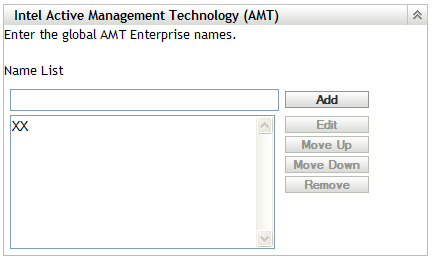
-
Fill in the fields:
Name List: This list should contain at least one valid AMT enterprise name for every AMT device in the Management Zone. Click to place each one into the list box.
Move Up/Move Down: Arranges the order in which the AMT names are listed. You can move only one at a time.
Remove: To remove names from the list, select them, then click .
-
Click either or to save the changes